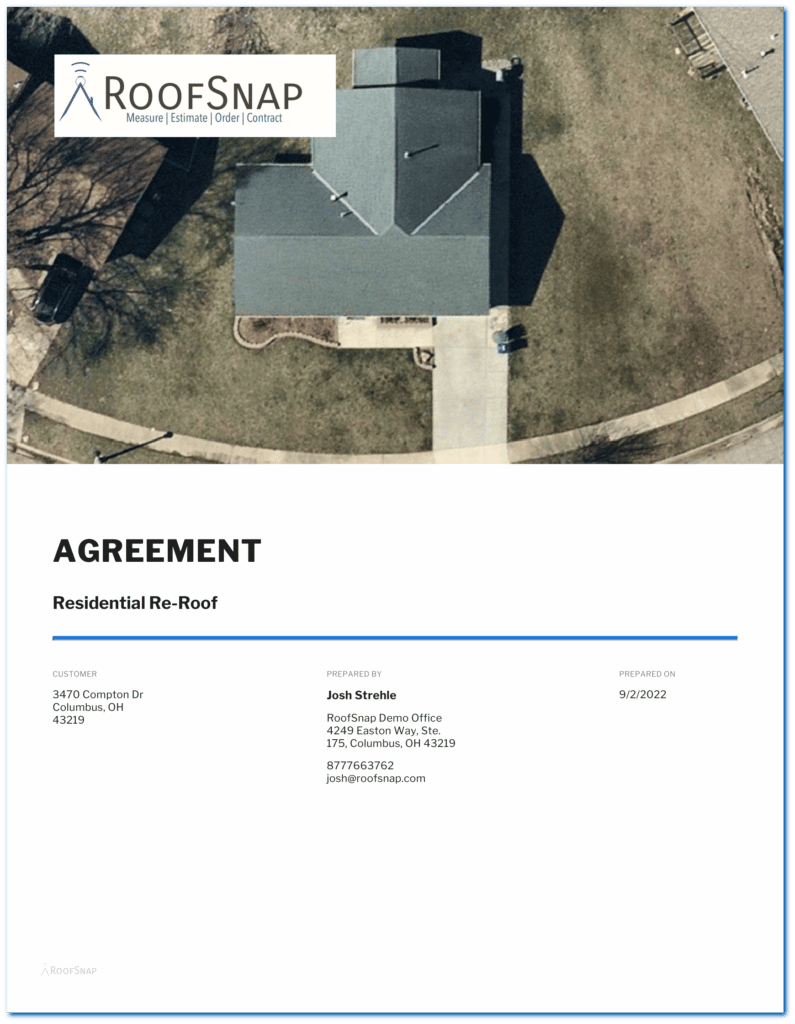Roofing is an industry on the rise. In 2020, the global roofing market was valued at $102.4 billion, and is predicted to reach $156 billion by 2030. That’s a compound annual growth rate of 4.3%. Looking at numbers like that, prospective roofers, or contractors who might be working for someone else, may well consider opening their own roofing businesses.
It’s not news to anyone that starting a company is challenging and risky at the best of times, much less during an uncertain economy. So while the roofing industry is booming, prospective roofers need a comprehensive guide to starting a business that will thrive for years to come. After all, there is a big difference between being an expert at installing slate and running a successful company.

Business Planning
Anyone looking to open their own business needs a solid and actionable business plan to get their idea off the ground. Before looking for financing, buying equipment – and definitely before hanging a shingle (literally or otherwise) – a business owner needs to think through every step of the entrepreneurial process.
While putting together a business plan, it is important to stay positive and keep that “new idea energy,” because excitement and optimism will inspire the best ideas and lead to the smartest solutions while fueling the entire planning process.
How Much Does It Cost to Start a Roofing Company?
The first thing to consider when founding any enterprise is cost. Roofers must account for the following as basic overhead:
- Insurance
- Equipment
- Wages
- Marketing
Thankfully, financing is available in the form of loans and grants from both the local and federal government, as well as private organizations dedicated to developing small businesses. Entrepreneurs of different backgrounds all have organizations willing to support their dreams if they do some research and fill out the right applications.
What is the average profit margin for roofing?
A successful business is one that makes more money than it loses, right? In any industry, it is important to know the average profit margin against which to measure success and growth.
For the average roofing company, gross profit margins run between 20 and 40 percent. New and larger companies may have slimmer margins: the former as they ramp up business and the latter due to higher overhead.
Is a Roofing Company Profitable?
The roofing industry is doing great, but before committing to a plan, it’s important to know the statistics on revenue. According to Roofing Contractor, a 2021 survey reported that primarily residential roofing contractors reported a median annual revenue of $500,000 to $4.9 million, with 14% actually reporting between $5 million to $9.9million. However, being able to determine what portion of that revenue is actually “profit” is what makes the difference in the bank. This is where understanding your profit margin becomes important.
How to Price Your Services
New business owners need a strategy for pricing their services to reach target profit margin. Pricing guides for the roofing industry are easy to find, but here is a basic step-by-step explanation of how to estimate a roofing job.
- Interview the client about the job, inspect the roof, and consider local building codes
- Measure the roof
- Estimate costs of roofing materials
- Estimate labor and rental costs
- Account for profit margin after overhead
Remember that 90 percent of roofers underbid for jobs, so it is vital to value one’s own services highly and charge their actual worth. Because the name of the game isn’t revenues: it’s profitability.
Branding Your Roofing Business
Running a roofing company involves a lot more than just fixing roofs. Small business owners wear a lot of hats, including that of Chief Brand Officer. A business’s brand is the first impression it makes on peers and potential clients, and can mean the difference between thriving and struggling.
Business Cards & Basics
The key to good branding is to explore all options for getting the word out about your company. Business cards are a tried and true option for roofers, but the modern age opens up plenty of great digital marketing opportunities for roofers. Websites, social media, branded email blasts, newsletters, and more can all spread the word about a new business. Likewise, asking satisfied customers to post reviews on services like Yelp or Google can go a long way to making a company look great.
What’s a Good Name for a Roofing Company?
All the branding in the world can’t help a company with an unmemorable name. Marketing research offers some key tips when choosing a name. For just a few rules of thumb, roofers should pick a name that appeals to their desired customers, that is comforting and familiar enough to be associated with home and family, and that features the name of the area being serviced.
Roofers should avoid overly long or confusing names, or that use unfamiliar language or contain business tags like LLC or Inc. that don’t actually apply to the company. It’s important to remember that the legal name of your company doesn’t need to be the public brand, but if you are doing business under a different name than your legal entity, you will need to file paperwork (usually known as a “fictitious business name”) with your local government.

Legal & Accounting Considerations for Your Roofing Business
Many new entrepreneurs worry about legal processes and bookkeeping, sometimes to the point of avoiding those tasks. But both legal coverage and accounting for business are easier and more straightforward than they appear, especially with modern software and plenty of resources online and elsewhere. The roofing community can point new roofers to helpful accountants and legal advisors or lawyers who are more than happy to offer advice.
What Business Type Should I Choose?
There are four basic business structures, each with its own benefits:
- Sole proprietorships – Run by one owner with all the decision-making power and liability
- Limited Liability Companies (LLCs) – More complex than a sole proprietorship but less so than a corporation, offering the owner more protection without too many complications
- S Corporation – S corporations pass the net income of the business onto the stockholders of the business in order for them to be taxed on their personal tax returns. Essentially, there’s only one tier of federal income tax to pay and it is a helpful business structure if there will be multiple partners in the business.
- C Corporation – Stockholders, officers, and the board of directors have total authority over the corporation. However, it is possible for an individual to fulfill all three roles. In other words, it’s possible to start a corporation and be in complete charge of every aspect of the business.
These structures and more exist to provide flexibility to the business owner, who should select the model best suited for the level of complexity they are willing to handle in exchange for liability protection and resilience.
What License Do You Need To Start A Roofing Company?
Starting a roofing company requires more than just the gumption to climb a ladder and start hammering nails. Every state has its own licensing requirements. Most such processes involve fees and dues, so it is important to research all the necessary steps and prepare a full business plan before committing to any tests or payments.
Roofing Insurance
Roofing does involve risk, both of personal injury and damage to property. There is no special insurance for roofing as an industry, but roofers can and should purchase as much insurance coverage as they can afford. Besides the two major categories covered below, roofers should also consider:
- Commercial auto insurance
- Contractor’s tools and equipment insurance
- Professional liability insurance
Individual projects may also come with surety bonds, wherein an insurer reimburses the client if the roofer fails to fulfill the contract.
General Liability Insurance
General liability insurance is there for basic third-party risks. This includes accidents, personal injury, property damage, and libel and branding injuries. Roofers can save money by bundling liability and commercial property insurance into a single policy.
Workers’ Compensation
Nearly every state requires business owners to pay into workers’ compensation programs, even if they have no employees. These policies help cover the costs of workplace injuries denied by health insurance.
Managing Your Accounts
Before getting a roofing business up and running, roofers may want to hire a dedicated accountant to handle the bookkeeping day-to-day. Freelance bookkeepers are available online and through services like Upwork, and are usually all a small business needs. The cost to retain these professionals on Upwork and similar sites is often well worth the extra time to complete or recharge between jobs.

Roofing Equipment
Roofing is a contracting and construction job. Working with one’s hands means holding the right tools. Aside from the basics like a hammer, screwdrivers, pliers, and more, roofers need items like:
- Roofing shovel or other tool to tear off shingles
- Pry bar
- Utility or roofing blade
- Air compressor
- Roofing hatchet
- Hammer tacker stapler
- Roofing nail gun
Renting vs Buying
Renting equipment is a great way to save on long-term expenses, upkeep costs, and commitment. When starting out, it’s a good idea to rent most big items, especially the ones that see situational use. As the business grows, it makes sense to buy the more commonly used equipment, and of course, roofers should own the basic tools they use every day.
Roofing Software
Business software has become indispensable in nearly every industry and roofing is no different. The right roofing software platform simplifies every aspect of a roofing business, from measurements to estimates to the all-important collection of data for analytics.
Estimate Software
Estimating and quoting the price of work is as sensitive as it is important. A good software platform automates the estimate process and makes it foolproof, making it much harder for the roofer to underquote for their hard work.
A good software platform also allows users to add notes and pictures from inspections even as it offers the best estimate tailored specifically to roofing on the market.

Measurement Software
Measuring a roof is one of the most vital steps in both the quoting and planning process. A premium roofing software not only stores all measurements but also uses aerial imaging for comprehensive and incredibly accurate measurements. Such measurements make estimates and invoicing much smoother, as well as help produce accurate roof measurement reports.
(Looking for a measurement ordering service instead? Try RoofSnap’s roof measurement report orders. The first one is on us.)

Contract Software
Roofers are contractors, and that means the contract itself is all-important for taking a job. Advanced roofing software tools should allow roofers to send contracts and receive signatures remotely, taking a lot of the waiting out of the contracting process. This is especially useful when paired with enhanced measurement systems and automated estimates. (Check out our Roofing Contract Software page for more details on RoofSnap & roofing contracts.)

___________________________________________________
Looking for an all-in-one Roofing Software solution?
___________________________________________________

Hiring Your Roofing Crew & Office Staff
While any contractor’s business often revolves around the owner’s reputation and skill (at least at first), running that business alone severely limits the potential for growth. Roofers need at least some staff, to make jobs safer, faster, and more efficient in the field, and to handle office tasks.
Hiring & Training Your Crew
Hiring and training the best staff is a major task. It is key to remember that finding experienced and skilled contractors is a great option, but so is training newcomers who show dedication and promise – don’t get caught up in the “Entry-Level Catch-22.”
Training is so rewarding that even resources for training trainers abound. Roofers Coffee Shop and Roofing Academy are just two options.
Job listings are easy (and often free) to post on sites like Craigslist, Indeed, and Google. And even with the dominance of online job hunting, newspapers remain a strong option for recruiting.
___________________________________________________
A good crew is hard to come by.
Curb turnover by downloading our “Guide to Retaining Top Talent”.
___________________________________________________
Hiring & Training “Office” Staff
Not every roofing business owner needs a formal office location, but office tasks like answering phones, organizing inventory and files, and data entry are mandatory regardless.
While these tasks are a good way to give younger relatives (paid!) work experience, it is easy to find enthusiastic office staff. Business owners need not be clerical wizards themselves to train staff in their preferred organizational methods, though letting an experienced office worker build best practices can be very rewarding.
Especially early on, freelancers can be an economical alternative to full-time or salaried hires.

Building Sales Infrastructure
Both field and office workers will be encountering potential clients, so all staff should be trained in sales techniques. Sales is a whole field that is difficult to master. Roofers who put a training plan and resources in place will set themselves up for success.
Ongoing Training
As with training other job skills, plenty of online influencers have channels dedicated to sales techniques. Many roofing business owners should start by training themselves using these same resources.
Online “influencers” like The Roof Strategist and The Roofershow can be great sources of training techniques.
Making Sales Easy
Word-of-mouth is one of the best ways to make sales without putting in too much effort. Setting up promotions and referral programs will encourage satisfied customers to tell their friends and family about a roofing business in hopes of receiving discounted service.

How Do I Make My Roofing Business Successful?
Starting a business is a challenge all its own – making that business thrive takes dedication, resourcefulness, and even luck. Here are just a few tips for improving one’s chances of becoming a prosperous roofer:
- Do plenty of research.
- Minimize your liability
- Work on sales skills
- Don’t overspend
- Hire reliable staff
- Take jobs you know you can complete
(For a more in-depth guide on scaling your business, we’ve got you covered.)
Digital Marketing
Any business owner should understand the basics of digital marketing. Paid online advertising like banners are one way to spread the word, while social media platforms like YouTube, Facebook, and NextDoor let business owners engage directly with potential clients.
When setting up a website and other online presence, search engine optimization (SEO) skills can mean the difference between being right up at the top of a Google search and banishment to the dreaded second page.
Traditional Marketing
Door-to-door salesmanship can get politicians elected, and it can definitely help bring customers to a roofing business. Pamphlets and fliers are valid options, especially if they include discounts and promotions, but sometimes just pounding the pavement and introducing oneself to local homeowners can really make an impression. Just be sure to convey friendliness and professionalism.
And never underestimate the power of networking. The roofing community is online like any other, from helpful subreddits and professional resources, and there are professional conventions and other meetups to attend. A friendly attitude toward fellow local roofers can help, even if they’re competitors in the market. It is also vital to cultivate working relationships with other trusted contractors in the area, as satisfied clients are likely to use, for example, their favorite landscaper’s recommended roofer, and vice versa.
KEEP READING: Roofing Lead Generation: 6 Ways to Get More Roofing Leads
Creating a Great Customer Experience
Ultimately, there is no better way to run a successful roofing business than to be a great roofer. And a great roofer knows the job is about more than just craftsmanship – professionalism and memorably good customer service are a must. Customers should be satisfied both with the completed project and how they are treated throughout the relationship.
To offer the best customer service, be sure to communicate openly and honestly, make eye contact, and keep calm at all times. Try whenever possible to see things from the customer’s perspective.
With the right business plan, staff, marketing, and customer relationships, any new roofing business can get in on the rising fortunes of this thriving industry.
Build Better a Better Business with RoofSnap
Try RoofSnap
for Free!

- Safety Standards and Training in the Roofing Industry

- The Parts of a Roof: A Comprehensive Guide for Roofers

- How Long Do Metal Roofs Last? Everything Roofers Need to Know

- Hip vs. Gable Roof: Which Options Should Roofers Recommend?

- Metal Roofing Colors: 5 Recommendations for Roofers

- The Roofer’s Guide to Roof Decking Materials and Installation



